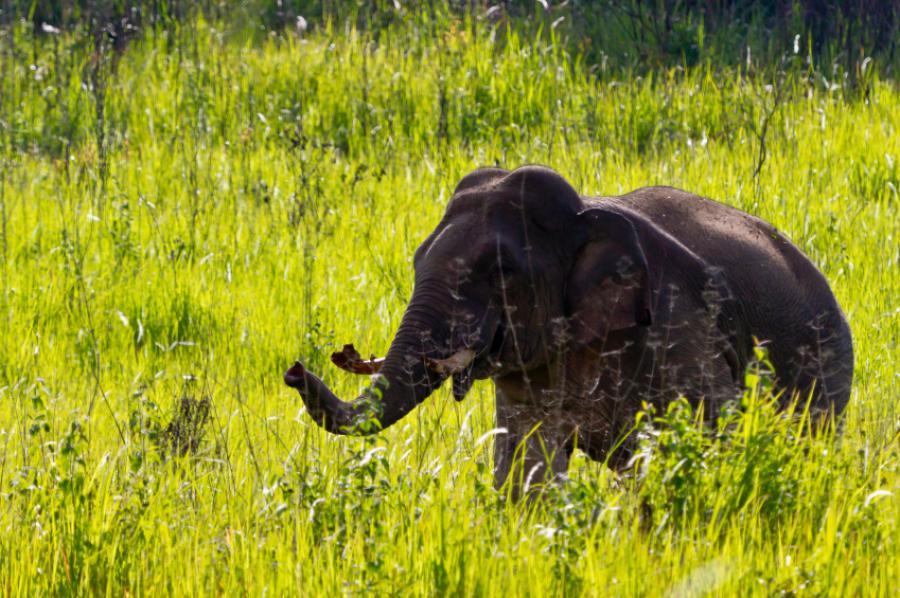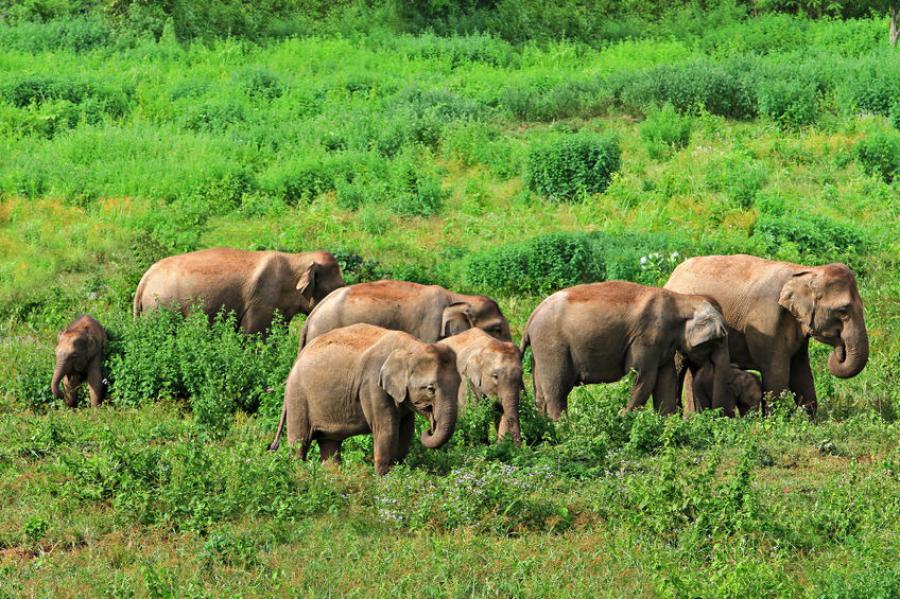About Kui Buri
Renowned as the premier spot for wild elephant watching in Thailand, Kui Buri National Park offers an impressive 95% chance of sighting these magnificent creatures in its dedicated wildlife viewing area.
Kui Buri National Park was established in 1999 and spans an area of 969 km² in Prachuap Khiri Khan Province, situated approximately 85 km southwest of the popular tourist destination Hua Hin.
The park's mountainous terrain is part of the Tenasserim Hills Range, which extends across several protected areas in both Thailand and Myanmar. The forest within the park comprises both dry and moist evergreen forests, featuring tree species such as Dipterocarpus tuberculatus, Hopea odorata, Terminalia chebula, and various species of palms.
Uniquely, Kui Buri National Park is the only location in Thailand where sandalwood can be harvested for the cremation of members of the royal family. For the cremation of King Bhumibol Adulyadej, nine sandalwood trees were selected. A royal Brahmin spent a month choosing trees that met the royal criteria: they had to be dead and over 100 years old. (source: Wikipedia).

The rainy season is May to November with the most rainfall in May and August to November. The rest of the year is quite dry.
Wildlife
The national park is home to one of the biggest populations of gaurs in Thailand, with estimated around 100 individuals and around 320 elephants (by 2016). In December 2013, 24 gaurs were found dead in the national park. Clinic tests concluded that the cause of death was bacterial. Following this incident, the national park was closed for eight months and re-opened again in August 2014. Few years later a herd of 70 gaurs were spotted feeding near one of the ranger stations, a good sign that the population was recovering.
Although not commonly seen, the national park probably has a similar rich diversity of mammal species as in Kaeng Krachan National Park to the north. Apart from Asian elephants and gaurs, the other relatively common mammals are golden jackals, various deer, langurs, white-handed gibbons, Burmese hares, Malayan porcupines and wild boars. Other interesting but rare mammals are tigers, leopards, bantengs, Malayan tapirs and dholes (Asiatic wild dogs).
Kui Buri has a rich fauna of birds with over 260 species currently reported from the park, there are probably many more to be found. Crested firebacks, grey peacock-pheasants, ferruginous partridges, Tickell's brown hornbills, white-crowned hornbills, brown fish owls, yellow-vented green pigeons, white-fronted scops owls, moustached hawk-cuckoos, rufous-collared kingfishers, blue-rumped parrots, chestnut-naped forktails, red-bearded bee-eaters, maroon woodpeckers, rufous-winged philentomas, spectacled spiderhunters, spot-necked babblers, moustached babblers and many more have been recorded from the park. Cattle egrets are seen daily around elephant herds. Other more common birds are red junglefowls, Indochinese rollers and Asian openbills.
Of the around 60 known reptile species found in the park are few interesting ones; red-headed kraits (Bungarus flaviceps), the southern variation of Pope's pit vipers (Trimeresurus popeiorum), dog-toothed cat snakes (Boiga cynodon), blunt-headed tree snakes (Aplopeltura boa), brown kukri snakes (Oligodon purpurascens), Indochinese ground snakes (Gongylosoma scriptum), speckle-headed whip snakes (Ahaetulla fasciolata), Drapiez's cat snakes (Boiga drapiezii), roughneck monitors (Varanus rudicollis), elongated tortoises (Indotestudo elongata), Burmese green lizards (Bronchocela burmana) and Malayan softshell turtles (Dogania subplana).
Visiting
A common mistake many visitors make when arriving at the park is entering "Kui Buri National Park" into their navigation system and following the suggested route. When you search this way, Google Maps or other navigation systems will direct you to the park's headquarters. However, this is not where the wildlife watching area is located, so it's crucial to know the correct destination.
To accurately locate the wildlife watching area and other relevant spots, it's best to open the map of Kui Buri National Park from this page. By zooming in and out or panning the map, you can identify the locations of different areas within the park, the roads, checkpoints, and, when sufficiently zoomed out, other nearby national parks and attractions.
Getting to the wildlife watching area
Kui Buri National Park has a single main wildlife watching area located at Huai Luek Ranger Station, approximately 16 km north of the headquarters.
You can find the location here:
https://maps.app.goo.gl/Z2gJPCHt4spE178K9
Visitors are not permitted to drive their own vehicles beyond the visitor center into the wildlife watching area. Instead, a safari pickup with a guide must be arranged at the visitor center. It's important to note that there is minimal wildlife activity near the visitor center, so if you wish to see elephants or other animals, you will need to arrange a guided safari into the park.
There are no public transportation options to reach the wildlife watching area, so private arrangements are necessary. You can get there by car or motorcycle. If traveling from Hua Hin or Pran Buri, the road conditions are generally good all the way to the visitor center.
The wildlife watching area is open daily from 2 pm to 6 pm, but significant wildlife activity typically occurs later in the afternoon. It is recommended that visitors arrive around 3 pm to allow time for arrangements. Arriving after 4:30 pm to 5 pm is not advisable, as there won't be enough time to reach the elephant watching areas and return before closing.
Getting to the headquarters area
There is literally nothing interesting to do at the headquarters area of the national park, even birdwatching possibilities are quite poor. There are no trails to walk around and walking along the road out will be along the tree plantations, farms and houses.
There is however a camping ground with basic facilities, but no restaurant.
Following are the coordinates of the headquarters area: 12.0516, 99.6240
Wildlife watching area - safari pickup cost
Safari pickups with a guide costs 850 Baht (will be increased to 1,000 Baht as of 1st October 2025) per group of max 6 people foreigners (max 8 Thai citizens for some odd reasons). The English level of the guides are none to very basic.
Private tours & transportation
It is possible to arrange a private tour from this website. The tour is with a professional English speaking guides who have good knowledge of the national park. For more details, follow this link;
Entrance fees
Once at the wildlife watching area, entrance fees need to be paid and a safari vehicle needs to be arranged at the visitor center.
As of June 2022, the entrance fees for Kui Buri National Park are 200 Baht for adults and 100 Baht for children 3-14 years old. Thai citizens pay 40 Baht for adults and 20 Baht for children. Cars will be charged with 30 Baht.
Opening times
The wildlife watching area is open from 2 pm until 6 pm every day all year round.
Stay & eat
There is no need to stay near the national park to see the elephants. The visitors are recommended to do a daytrip from Hua Hin or other nearby towns where it is easy to arrange transportation from.
There are no camping grounds or other accommodations for rent at the wildlife watching area, but there is a basic restaurant and a cafe next to the visitor center.
Kuri Buri headquarters area has a campsite with a visitor center and basic facilities but no restaurant. Tents are available for rent at the visitor center from 270 Baht a night including accessories. There is only one room for rent, it has 3 bedrooms and 2 toilets, for 1,800 Baht per night. Bringing your own tent will be charged with 30 Baht per night which is a standard fee in all national parks in Thailand.
Phone(s)
You are recommended to ask a Thai speaking person to call on your behalf.
- 081 776 2410 (Visitor Center)
- 032 646 292 (Visitor Center)
- 090 442 8707 (Wildlife watching area)
Attractions of Kui Buri
Huai Luek Elephant Watching Area
It is the only spot in the national park where wild elephants and possibly other animals can be seen from safari vehicles. Apart from the elephants, there is some chance to see gaurs, deer, jackals and Burmese hares.
On arrival at the ranger station, a safari vehicle must be arranged to enter the wildlife watching area. These can’t be arranged in advance. The safari vehicles are converted pickups with seats mounted on the trunk. The safari vehicles don't have any roofs, open so that the visitors have clear 360 degrees of visibility. Umbrellas provided in case of rain.
A safari tour costs 850 per group but the visitors are recommended to give some tips to the drivers and to the guides (not mandatory).
The wildlife watching area is open from 2 pm until around 6 pm daily. When enough elephants are seen the tour may end earlier on request. Visitors are recommended to visit the area in the late afternoon as there won't be much wildlife activity in the earlier hours. Wildlife becomes gradually active from around 3-3:30 pm onward. Visitors from Hua Hin are recommended to leave the town around 1:30 pm. Visitors won't be allowed to enter the wildlife watching area after 5 pm, but once inside, the tour can continue up until 6 pm, often ending earlier if enough elephants are seen.
The station has a large car parking area, toilets, a visitor center, a restaurant and a cafe.

The wildlife watching area north from the substation is a forested area with several grassland areas. Two of the grassland areas have viewpoints with nice views over surrounding areas. While doing a safari trip the local guides will inform each other with walkie talkies when they see animals which increases the chances to see various animals.